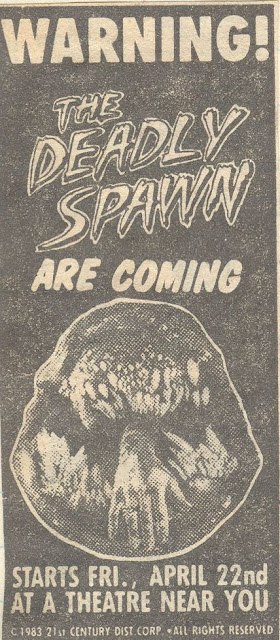
It's very easy to believe this 1952 horror movie is something I dreamed up in a sweaty, delirious haze. But, no, I took my temperature and my pulse, and I'm feeling fine. So MESA OF LOST WOMEN must be a real movie.
Quite probably one of the worst films I've ever seen, MESA OF LOST WOMEN plays like a jittery delight, an ethereal neverland where normal laws of logic and physics don't apply. A land of midgets and giant spiders, mad scientists and genteel psychopaths, where the women are stacked and the audience is stumped.
According to Bill Warren's essential
KEEP WATCHING THE SKIES, MESA OF LOST WOMEN was produced in 1952, but not released in Los Angeles in 1956, during the period when the infamous Edward D. Wood, Jr. was flooding theaters with his peculiar style of cinematic ineptitude. MESA even feels like something Wood might have concocted on the back of a cocktail napkin in a dive on Sunset. In fact, the maddening musical score composed for the picture by Hoyt Curtin later turned up on the soundtrack of Wood's JAIL BAIT.
Once you've heard Curtin's repetitive Mexican-guitar-and-pounding-piano opus, you aren't likely to forget it, as it drowns the picture in a cacophony of noise that sounds as though it were performed by a pair of monkeys locked in a junior high school band room. An interesting footnote is that Curtin ended up at Hanna-Barbera, composing themes and scores for some of the most famous animated series in television history, including THE FLINTSTONES, THE JETSONS, JONNY QUEST, and SCOOBY-DOO, WHERE ARE YOU?
MESA OF LOST WOMEN stars Jackie Coogan (that's right--Uncle Fester!) as Dr. Aranya ("That's Spanish for spider!"), a mad scientist living atop Mesa Zarpa, perched 600 feet above the Mexican desert. For some idiotic reason, Aranya is attempting to breed humans with spiders in order to create a master race to do his bidding. For an even more idiotic reason, the experiments transform the men into mute midgets, whereas the women become sexy Amazons with long fingernails.
Aranya summons a fellow scientist, Masterson (Harmon Stevens), to his laboratory in order to share his secrets with the scientific community. The results drive Masterson mad, however, and he is sentenced to a mental hospital and lobotomized. Somehow, he escapes and shows up at a cantina, where Tarantella (Tandra Quinn) is performing a steamy spider dance. Masterson shoots her and kidnaps a millionaire, his golddigging fiancé, his Chinese servant, and Masterson's male nurse.
Masterson takes his captives to their airplane and forces pilot Grant Phillips (Robert Knapp) to fly them to Mesa Zarpa, where, uh, where not much happens, really. The nurse and the millionaire are killed (off-screen) by a giant spider, and the rest of the party ends up in Aranya's underground lab. Masterson recovers his sanity long enough to send Phillips and his new squeeze on their way safely, and then blow the lab all to hell, destroying Aranya's mad dream and himself in the process.
All of this happens in about 68 minutes and is actually more compressed than that. MESA opens with a prologue that has nothing to do with the rest of the movie, showing Tarantella planting a kiss of death on an unassuming male victim and then incomprehensible narration written by co-director Herbert Tevos (who doesn't appear to have made another picture) and delivered by Lyle Talbot (JAIL BAIT), another reminder of the Wonderful World of Ed Wood. Talbot rambles deliciously about "hexapods" and the perils of Muerto Desert--"the desert of Death."
Although a handful of minor B-movie actors signed on to Tevos and co-director Ron Ormond's lunacy, including Allan Nixon (PREHISTORIC WOMAN) and Richard Travis (Lou Gehrig in THE BABE RUTH STORY), the only performer you're likely to recognize is Coogan, who later played the eccentric Uncle Fester on THE ADDAMS FAMILY. A famous child actor, Coogan had not yet made many waves in his adult career, except for starring in an obscure syndicated series with the unlikely title of COWBOY G-MEN. He doesn't appear to be enjoying MESA very much, basically walking through the (probably) two days he spent on the set. Sporting thick eyeglasses, a goatee, and a mole, he almost looks as though he's trying to hide, thankful for the house payment he was able to make that month because of his MESA paycheck. Coogan went on to appear in a couple of Albert Zugsmith productions, including the magnificent HIGH SCHOOL CONFIDENTIAL as a drug kingpin, and even produced and directed an obscure espionage B-flick under his own Coogan Films banner before hitting it big opposite John Astin and Carolyn Jones on THE ADDAMS FAMILY.
 The first of American International’s enormously popular Beach Party series, unlike the rest, gives the biggest parts to adults.
The first of American International’s enormously popular Beach Party series, unlike the rest, gives the biggest parts to adults.






